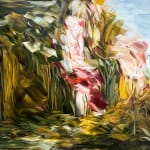Megan Baker British, b. 1996
Fled Across the Wilds III, 2024
oil on canvas
165 x 200 cm
Further images
The myth of Pan and Syrinx illustrates themes of unrequited love and transformation. Pan, the god of the wilderness, becomes infatuated with Syrinx, a nymph who cherishes her independence. To...
The myth of Pan and Syrinx illustrates themes of unrequited love and transformation. Pan, the god of the wilderness, becomes infatuated with Syrinx, a nymph who cherishes her independence. To escape his persistent advances, Syrinx flees to the banks of a river, where she implores the river nymphs for assistance. In a desperate bid to evade Pan, she is transformed into a cluster of reeds.
Upon losing Syrinx and discovering the reeds, Pan is struck by their melancholic sound when the wind passes through them. In his grief and longing, he fashions the pan flute (or syrinx) from the very reeds that conceal her. This instrument serves as a poignant reminder of his unfulfilled desire and the bittersweet nature of love. The narrative ultimately underscores the complexities of desire, the inevitability of transformation, and the profound impact of loss.
Baker’s works reveal a focus on the natural landscape, addressing the idea of transformation from human body into vegetation. More specifically, Baker looks at the significance embedded in the shift in perception of nature itself: Syrinx, being a huntress, finds comfort and solitude in the forest until it becomes the setting of her escape from Pan; what once offered protection has now been disrupted through the imposition of power. What is it to continually transform yourself at the hands of malevolence? Asks Baker.
Pan and Syrinx by Workshop of Jan Brueghel the Younger
Upon losing Syrinx and discovering the reeds, Pan is struck by their melancholic sound when the wind passes through them. In his grief and longing, he fashions the pan flute (or syrinx) from the very reeds that conceal her. This instrument serves as a poignant reminder of his unfulfilled desire and the bittersweet nature of love. The narrative ultimately underscores the complexities of desire, the inevitability of transformation, and the profound impact of loss.
Baker’s works reveal a focus on the natural landscape, addressing the idea of transformation from human body into vegetation. More specifically, Baker looks at the significance embedded in the shift in perception of nature itself: Syrinx, being a huntress, finds comfort and solitude in the forest until it becomes the setting of her escape from Pan; what once offered protection has now been disrupted through the imposition of power. What is it to continually transform yourself at the hands of malevolence? Asks Baker.
Pan and Syrinx by Workshop of Jan Brueghel the Younger
Provenance
artist studioExhibitions
'Time is Always New' by Megan Baker & Eleanor Johnson, 3rd October - 15 November, Gillian Jason Gallery, London UK1
of
2







